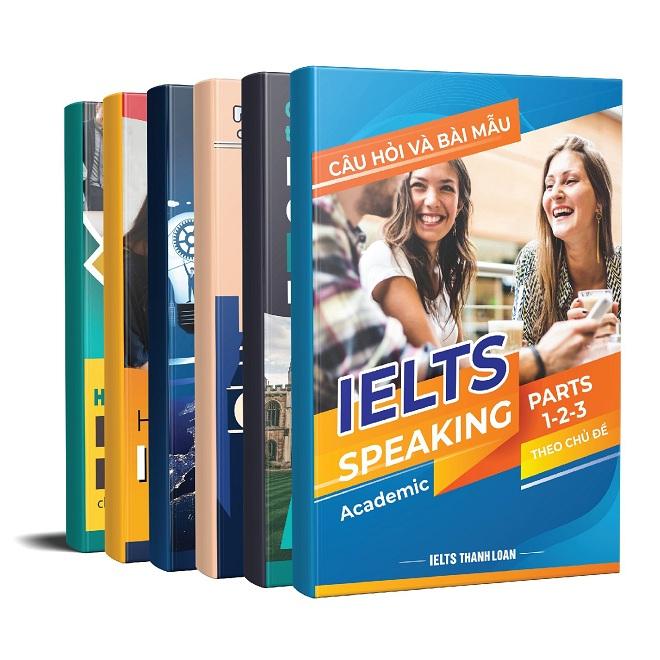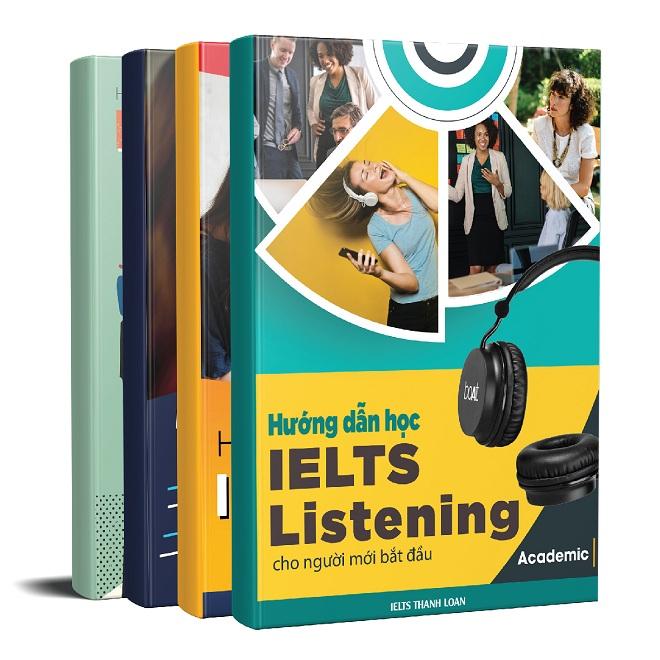Bạn đang ôn luyện với sách IELTS Listening và muốn cải thiện kỹ năng làm bài? Trong bài viết này, Trung tâm IELTS Thanh Loan sẽ cung cấp lời giải chi tiết cho The Official Guide to IELTS – Listening Test 7, kèm theo transcripts và đáp án đầy đủ. Cùng khám phá cách xử lý từng dạng câu hỏi để nâng cao điểm số ngay nhé!
Section 1: Hostel accommodation in Darwin
Questions 1-6
Complete the table below.
Write NO MORE THAN ONE WORD AND/OR A NUMBER for each answer.
| Name | Price per person (dormitory rooms) | Comments and reviews |
| Example
Top End Backpackers |
$19 |
|
| Gum Tree Lodge | 3 $………………….. |
|
| Kangaroo Lodge | $22 |
|
Questions 7-10
Complete the notes below.
Write ONE WORD ONLY for each answer.
|
Kangaroo Lodge Address: on 7………………….. Lane General information about hostel accommodation
|
Xem thêm:
- Dịch, giải IELTS Listening Official Guide to IELTS Test 1 đến 8
- Dịch song ngữ, giải IELTS Reading Official Guide Test 1 đến 8
Julie: Hi Nick. It’s Julie. Have you managed to find any information about accommodation in Darwin?
Julie: Chào Nick. Đó là Julie. Bạn đã tìm được bất kỳ thông tin nào về chỗ ở ở Darwin chưa?
Nick: Hi. I was just going to call you. I’ve found some on the Internet. There are quite a few hostels for backpackers there. The first possibility I found was a hostel called Top End Backpackers.
Nick: Xin chào. Tôi đang định gọi cho bạn. Tôi đã tìm thấy một số thông trên Internet. Có khá nhiều ký túc xá cho khách du lịch ba lô ở đó. Khả năng đầu tiên tôi tìm thấy là một ký túc xá có tên là Top End Backpackers.
Julie: OK.
Julie: OK.
Nick: It’s pretty cheap, you can get a bed in a dormitory for nineteen dollars per person. Private rooms cost a bit more, but we’ll be OK in dormitories, won’t we?
Nick: Nó khá rẻ, bạn có thể thuê một chỗ trong ký túc xá với giá 19 đô la một người. Phòng riêng đắt hơn một chút, nhưng ở ký túc xá ổn, phải không?
Julie: Sure.
Julie: Chắc chắn rồi.
Nick: So that hostel has parking, though that doesn’t really matter to us as we’ll be using public transport.
Nick: Vậy là ký túc xá đó có bãi đậu xe, mặc dù điều đó không thực sự quan trọng đối với chúng ta vì chúng ta sẽ sử dụng phương tiện công cộng.
Julie: Yeah. Are there any reviews on the website from people who’ve been there?
Julie: Ừ. Có bất kỳ đánh giá nào trên trang web từ những người đã từng ở đó không?
Nick: Well, yes. They aren’t all that good though. Some people said they didn’t like the staff, they had an unfriendly attitude (Q1).
Nick: Có. Tuy nhiên, không phải đánh giá nào cũng tốt. Một số người cho biết họ không thích nhân viên, họ có thái độ không thân thiện.
Julie: Mmm. That’s quite unusual in a hostel, usually all the staff are really welcoming.
Julie: Ừm. Đó là điều khá lạ trong một ký túc xá, thường là tất cả các nhân viên thực sự chào đón khách hàng.
Nick: That’s what I thought. People said they liked the pool, and the fact that the rooms had air-conditioning, but the problem with that was that it was very noisy (Q2), so they were kept awake. But it was too hot if they turned it off, so they had to put up with it.
Nick: Đó là những gì tôi nghĩ. Mọi người nói rằng họ thích hồ bơi, và thực tế là các phòng đều có máy lạnh, nhưng vấn đề là nó rất ồn, vì vậy họ luôn bị thức. Nhưng trời quá nóng nếu họ tắt nó đi, vì vậy họ phải chịu đựng nó.
Julie: Someone told me there’s another hostel called Gum Tree something.
Julie: Có người nói với tôi rằng có một ký túc xá khác tên là Gum Tree gì đó.
Nick: Gum Tree Lodge. It costs a bit more, forty-five dollars a person.
Nick: Gum Tree Lodge. Nó có giá cao hơn một chút, 45 đô la một người.
Julie: What?
Julie: Cái gì?
Nick: Oh, no, that’s for private rooms, it’s twenty-three fifty for the dorms (Q3).
Nick: Ồ, không, đó là cho phòng riêng, là 23.50 cho ký túc xá.
Julie: That’s more like it.
Julie: Như vậy thì đúng hơn.
Nick: It looks to be in quite a good location, a bit out of town and quiet but with good transport, and quite near a beach.
Nick: Nó có vẻ ở một vị trí khá tốt, hơi xa thị trấn và yên tĩnh nhưng với giao thông tốt, và khá gần bãi biển.
Julie: Has it got a pool?
Julie: Nó có hồ bơi à?
Nick: Yes, and its own gardens. The reviews for that one are mostly OK except for one person who said they couldn’t sleep because there were insects flying around in the dormitories (Q4).
Nick: Ừ, và những khu vườn của riêng nó. Các đánh giá cho chỗ này hầu hết đều ổn ngoại trừ một người nói rằng họ không thể ngủ được vì có côn trùng bay xung quanh trong ký túc xá.
Julie: Not for me then. And I’d rather be somewhere central really.
Julie: Không dành cho tôi rồi. Và tôi muốn ở một nơi nào đó thực sự trung tâm.
Nick: Right. There’s a place called Kangaroo Lodge. They’ve got dorms at twenty-two dollars. And it’s downtown, near all the restaurants and clubs and everything, so that should suit you. And it doesn’t close at night.
Nick: Được thôi. Có một nơi tên là Kangaroo Lodge. Họ có ký túc xá với giá 22 đô la. Và nó ở trung tâm thành phố, gần tất cả các nhà hàng và câu lạc bộ và mọi thứ, vì vậy sẽ phù hợp với bạn. Và nó không đóng cửa vào ban đêm.
Julie: So there’s always someone on reception. That sounds good.
Julie: Thế thì luôn có một người trực ở khu vực tiếp tân. Nghe hay đấy.
Nick: The only criticism I saw was that the rooms were a bit messy and untidy because people just left their clothes and stuff all over the beds and the floor.
Nick: Lời chỉ trích duy nhất tôi thấy là các phòng hơi lộn xộn và không gọn gàng vì mọi người hay để quần áo và đồ đạc trên giường và sàn nhà.
Julie: Don’t hostels usually have lockers in the bedrooms where you can leave your stuff?
Julie: Không phải ký túc xá thường có tủ khóa trong phòng ngủ để bạn có thể để đồ của mình sao?
Nick: Yeah, they do usually, but apparently they don’t here. Still, hostels are never particularly tidy places, so that doesn’t bother me. And the same person said that the standard of cleanliness was pretty good, and especially the bathrooms, they were excellent as far as that went (Q5).
Nick: Ừ, thường là thế, nhưng dường như họ không có tủ ở đây. Tuy nhiên, ký túc xá chưa bao giờ là nơi đặc biệt ngăn nắp, vì vậy điều đó không làm phiền tôi. Và cùng một người đó nói rằng tiêu chuẩn về độ sạch sẽ khá tốt, và đặc biệt là phòng tắm, chúng rất xuất sắc cho đến thời điểm đó.
Julie: Right. Yeah, I reckon Kangaroo Lodge sounds the best.
Julie: Được rồi. Tôi nghĩ Kangaroo Lodge nghe ổn nhất đấy.
Nick: Me too. Quite a lot of people reviewing it said it was really fun there, like every night everyone staying there got together and ended up having a party (Q6). So it sounds like it’s got a really good atmosphere.
Nick: Tôi cũng vậy. Rất nhiều người đánh giá nó nói rằng nó thực sự rất vui, như kiểu mọi đêm mọi người tụ tập lại với nhau và mở tiệc. Bầu không khí rất tuyệt vời.
Julie: OK, let’s go for that one.
Julie: OK, chúng ta hãy bắt đầu cái đó.
Julie: Did you get the address of Kangaroo Lodge?
Julie: Bạn có lấy được địa chỉ của Kangaroo Lodge không?
Nick: Yes … it’s on Shadforth Lane.
Nick: Có… nó ở Shadforth Lane.
Julie: Can you spell that?
Julie: Bạn có thể đánh vần không?
Nick: S-H-A-D-F-O-R-T-H (Q7). It’s near the transit centre where the intercity buses and the airport buses drop you off.
Nick: S-H-A-D-F-O-R-T-H. Nó gần trung tâm trung giao thông công cộng nơi xe buýt liên tỉnh và xe buýt sân bay đưa bạn đến.
Julie: Cool. I’m really looking forward to this. I’ve never stayed in a hostel before. Do they provide bed linen – sheets and things?
Julie: Tuyệt. Tôi thực sự mong đợi điều này. Tôi chưa bao giờ ở trong một ký túc xá trước đây. Họ có cung cấp bộ khăn trải giường và những thứ khác không?
Nick: Yeah. And you can usually either bring your own towel, or hire one there, but they don’t usually provide those for free (Q8).
Nick: Có. Và bạn thường có thể mang theo khăn tắm của mình, hoặc thuê một cái ở đó, nhưng họ thường không cung cấp miễn phí.
Julie: OK. And what happens about meals?
Julie: Được. Bữa ăn thì sao?
Nick: Well, you don’t have to pay extra for breakfast (Q9). It varies a lot in different places but generally, it’s OK. And there’s usually a café where you can buy a snack or a hot meal for lunch. But actually, if you’re really travelling on the cheap, usually for every five or six rooms there’s a kitchen (Q10) where you can knock up a snack, and that saves a lot of money.
Nick: Chà, bạn không phải trả thêm tiền cho bữa sáng. Bữa sáng khác nhau ở những nơi khác nhau nhưng nói chung là ổn. Và thường có một quán cà phê nơi bạn có thể mua một món ăn nhẹ hoặc một bữa ăn nóng cho bữa trưa. Nhưng thực ra nếu bạn thực sự đi du lịch giá rẻ, thường thì cứ năm hoặc sáu phòng sẽ có một nhà bếp, nơi bạn có thể chế biến đồ ăn nhẹ, và điều đó tiết kiệm được rất nhiều tiền.
Julie: Great. Right, well shall I go ahead and book that…
Julie: Tuyệt vời. Được rồi, tôi sẽ tiếp tục và đặt chỗ đó…
| Đáp án | Từ vựng trong câu hỏi | Từ vựng trong transcript |
| Q1. unfriendly | ||
| Q2. noisy | ||
| Q3. 23.50 | ||
| Q4. insects | ||
| Q5. bathrooms | Very clean | Cleanliness was pretty good |
| Q6. party | ||
| Q7. Shadforth | ||
| Q8. towel | ||
| Q9. breakfast | Is included | Don’t have to pay extra |
| Q10. kitchen |
Section 2: Anglia Sculpture Park
Questions 11-16
Choose the correct letter, A, B or C.
11. The land where the Sculpture Park is located was previously
- A. completely covered by forest.
- B. the site of a private house.
- C. occupied by a factory.
12. What is unusual about the Anglia Sculpture Park?
- A. Artists have made sculptures especially for it.
- B. Some of its sculptures were donated by the artists.
- C. It only shows contemporary sculptures.
13. What is the theme of Joe Tremain’s ‘burnt’ sculptures?
- A. the contrast between nature and urban life
- B. the effect of man on the environment
- C. the violence of nature
14. The path by the Lower Lake
- A. is rather wet in some places.
- B. has recently been repaired.
- C. is difficult to walk on.
15. What does the speaker say about the Visitor Centre?
- A. It is being enlarged at present.
- B. It has received an international award.
- C. It was designed by a Canadian architect.
16. Today, visitors can buy snacks and sandwiches
- A. at the kiosk.
- B. in the Terrace Room.
- C. at the Lower Lake Cafe.
Questions 17-20: Label the map below. Write the correct letter, A-F, next to Question 17-20.

17. Joe Tremain sculptures
18. Giorgio Catalucci bird sculptures
19. Garden Gallery
20. Long House
Hello everyone and welcome to the Anglia Sculpture Park. Right, well, the idea behind the sculpture park is that it’s a place where works of art such as large sculptures and carvings can be displayed out of doors in a natural setting.
Xin chào tất cả mọi người và chào mừng đến với Công viên Điêu khắc Anglia. Đúng vậy, ý tưởng đằng sau công viên điêu khắc đó là nơi mà các tác phẩm nghệ thuật như tác phẩm điêu khắc và chạm khắc lớn có thể được trưng bày ngoài cửa trong một khung cảnh tự nhiên.
As you’ll have noticed when you drove here, most of the land around the park is farmland. The park itself belonged to a family called the De Quincies, who had made a lot of money from manufacturing farm machinery, and who also owned substantial stretches of forest land to the north of the park. They built a house in the centre of the park, not far from where we’re standing now (Q11), but this burnt down in 1980 and the De Quincies then sold the land.
Như bạn sẽ nhận thấy khi bạn lái xe đến đây, hầu hết đất xung quanh công viên là đất nông nghiệp. Bản thân công viên thuộc về một gia đình có tên là De Quincies, người đã kiếm được rất nhiều tiền từ việc sản xuất máy móc trang trại và cũng là người sở hữu những khu đất rừng đáng kể ở phía bắc của công viên. Họ đã xây một ngôi nhà ở trung tâm công viên, không xa nơi chúng ta đang đứng bây giờ, nhưng ngôi nhà này đã bị cháy vào năm 1980 và De Quincies sau đó đã bán đất.
The Anglia Sculpture Park isn’t the only one in the country; several of the London parks sometimes display contemporary sculptures, and there are a couple of other permanent sculpture parks in England. But we’re unique in that some of our sculptures were actually created for the sites they occupy here (Q12), and we also show sculptures by a wider range of artists than anywhere else in the country.
Công viên Điêu khắc Anglia không phải là công viên duy nhất trong cả nước; một số công viên ở London đôi khi trưng bày các tác phẩm điêu khắc đương đại, và có một vài công viên điêu khắc lâu đời khác ở Anh. Nhưng chúng tôi độc đáo ở chỗ một số tác phẩm điêu khắc của chúng tôi thực sự được tạo ra cho các địa điểm ở đây, và chúng tôi cũng trưng bày các tác phẩm điêu khắc của nhiều nghệ sĩ hơn bất kỳ nơi nào khác trên cả nước.
For example, at present, we have an exhibition by Joe Tremain, of what he calls ‘burnt’ sculptures. These are wood and stone sculptures that he’s carved and marked with fire to illustrate the ferocity and intensity of the forces that have shaped our planet over millions of years (Q13). They look really dramatic in this rural setting.
Ví dụ, hiện tại, chúng tôi có một triển lãm của Joe Tremain, về cái mà ông gọi là các tác phẩm điêu khắc ‘bị cháy’. Đây là những tác phẩm điêu khắc bằng gỗ và đá mà anh ấy đã chạm khắc và đánh dấu bằng lửa để minh họa sự hung dữ và cường độ của các lực đã hình thành hành tinh của chúng ta qua hàng triệu năm. Chúng trông thực sự ấn tượng trong khung cảnh nông thôn này.
To see some of the sculptures, you’ll need to follow the path alongside the Lower Lake. We had to renovate this (Q14) after the lake overflowed its banks a couple of months ago and flooded the area. The water level’s back to normal now and you shouldn’t have any trouble, the path’s very level underfoot.
Để xem một số tác phẩm điêu khắc, bạn sẽ cần đi theo con đường dọc theo Hồ Lower. Chúng tôi đã phải cải tạo nó sau khi hồ tràn bờ vài tháng trước và gây ngập lụt khu vực. Mực nước hiện đã trở lại bình thường và bạn sẽ không gặp bất kỳ khó khăn nào.
You should be back at the Visitor Centre at about four o’clock. If you have time it’s worth taking a look at the Centre itself. It’s not possible to go upstairs at present as builders are working there adding another floor (Q15), but the rest’s well worth seeing. The architect was Guy King. He was actually born in this part of England but he recently designed a museum in Canada that won a prize for innovation in public buildings.
Bạn sẽ trở lại Trung tâm Du khách vào khoảng bốn giờ. Nếu bạn có thời gian, bạn nên xem qua Trung tâm. Hiện tại, không thể lên tầng trên vì các nhà xây dựng đang làm việc ở đó để xây thêm một tầng khác, nhưng phần còn lại rất đáng xem. Kiến trúc sư là Guy King. Ông ấy sinh ra ở vùng này của Anh nhưng gần đây ông ấy đã thiết kế một bảo tàng ở Canada và đã giành được giải thưởng về sự đổi mới trong các tòa nhà công cộng.
If you want to get something to eat when you get back, like a snack or a sandwich, the Terrace Room is currently closed, but you can go to the kiosk and buy something (Q16), then sit on one of the chairs overlooking the Lower Lake and enjoy the view as you’re eating.
Nếu bạn muốn ăn gì đó khi trở về, chẳng hạn như đồ ăn nhẹ hoặc bánh mì, Phòng Terrace hiện đang đóng cửa, nhưng bạn có thể đến ki-ốt và mua thứ gì đó, sau đó ngồi trên một trong những chiếc ghế nhìn ra Hồ Lower và tận hưởng quang cảnh khi bạn đang ăn.
Now, let me just tell you a bit about what you can see in the Sculpture Park. If you look at your map, you’ll see the Visitor Centre, where we are now, at the bottom, just by the entrance. Since we only have an hour, you might not be able to get right around the park, but you can choose to visit some of the highlights.
Bây giờ, hãy để tôi chỉ cho bạn biết một chút về những gì bạn có thể nhìn thấy trong Công viên điêu khắc. Nếu bạn nhìn vào bản đồ của mình, bạn sẽ thấy Trung tâm Du khách, nơi chúng ta hiện đang đứng, ở phía dưới, ngay cạnh lối vào. Vì chúng ta chỉ có một giờ, bạn có thể không đi được ngay quanh công viên, nhưng bạn có thể chọn tham quan một số địa điểm nổi bật.
You might like to take a look at the Joe Tremain sculptures which are displayed on this side of the Upper Lake just behind the Education Centre and near the bridge (Q17). They’re really impressive, but please remember not to let your children climb on them.
Bạn có thể muốn xem các tác phẩm điêu khắc của Joe Tremain được trưng bày ở phía bên này của Hồ Upper, ngay sau Trung tâm Giáo dục và gần cây cầu. Chúng thực sự ấn tượng, nhưng hãy nhớ đừng để con bạn trèo lên chúng.
One of our most popular exhibitions is the Giorgio Catalucci bird sculptures – they’re just across the bridge on the north side of Lower Lake (Q18). I love the way they’re scattered around in the long grass beside the lake, looking as if they’re just about to take to their wings.
Một trong những triển lãm nổi tiếng nhất của chúng tôi là các tác phẩm điêu khắc chim của Giorgio Catalucci – chúng nằm ngay bên kia cầu ở phía bắc của Hồ Lower. Tôi thích cách chúng nằm rải rác trên bãi cỏ dài bên hồ, trông như thể chúng sắp cất cánh.
You could also go to the Garden Gallery. It’s on this side of the Upper Lake – from the Visitor Centre you go to the Education Centre, then keep on along the path, and you’ll see it on your right (Q19). There’s an exhibition of animal carvings there which is well worth a look.
Bạn cũng có thể đến Garden Gallery. Nó ở bên này của Hồ Upper – từ Trung tâm Du khách, bạn đi đến Trung tâm Giáo dục, sau đó tiếp tục đi dọc theo con đường, và bạn sẽ thấy nó ở bên phải của mình. Có một cuộc triển lãm về chạm khắc động vật ở đó rất đáng xem.
We also have the Long House – that’s quite a walk. From here, you go to the bridge and then turn left on the other side. Soon you’ll see a winding pathway going up towards the northern boundary of the park – go up there and you’ll find it at the top (Q20). They have some abstract metal sculptures that are well worth seeing if you have time. OK well now if you’re …
Chúng tôi cũng có Nhà dài – đi ở đó như đi dạo vậy. Từ đây, bạn đi đến cây cầu và sau đó rẽ trái ở phía bên kia. Chẳng bao lâu bạn sẽ thấy một con đường quanh co đi lên về phía ranh giới phía bắc của công viên – đi lên đó và bạn sẽ thấy nó ở trên cùng. Họ có một số tác phẩm điêu khắc kim loại trừu tượng rất đáng xem nếu bạn có thời gian. Được rồi, bây giờ nếu bạn …
| Đáp án | Từ trong câu hỏi | Từ/ cụm từ trong scripts |
| Q11. B | the site of the private house | built a house in the centre of the park |
| Q12. A | artists have made sculptures especially for it | created for the sites they occupy here |
| Q13. C | the violence of nature | the ferocity and intensity of the forces that have shaped our planet over millions of years |
| Q14. B | recently been repaired | to renovate this |
| Q15. A | being enlarged at present | builders are working there adding another floor |
| Q16. A | buy snacks and sandwiches at the kiosk | go to the kiosk and buy something |
| Q17. E | ||
| Q18. C | ||
| Q19. F | ||
| Q20. A |
Vocabulary
- sculpture /ˈskʌlptʃə(r)/ (noun): tác phẩm điêu khắc
- contemporary /kənˈtemprəri/ (adj): đương đại
- ferocity /fəˈrɒsəti/ (noun): bạo lực, sự dữ dội
- kiosk /ˈkiːɒsk/ (noun): ki-ốt
- winding /ˈwaɪndɪŋ/ (adj): quanh co
Tự học IELTS tại nhà chỉ từ 1.2 triệu? Tham khảo ngay Lớp IELTS Online từ IELTS Thanh Loan
Học IELTS trực tuyến linh hoạt với format video bài giảng
Giải pháp tự học IELTS tại nhà, tiết kiệm chi phí, linh hoạt thời gian nhưng đảm bảo hiệu quả. Khóa học dạng video bài giảng có lộ trình học từng ngày chi tiết. Học viên học lý thuyết qua video bài giảng, thực hành Listening Reading trực tiếp trên website, còn Writing Speaking được chấm chữa trực tiếp bởi cô Thanh Loan. Mọi bài giảng đều có tài liệu học tập đi kèm.

Section 3: Marketing report
Questions 21-26
Choose the correct letter, A, B or C.
21. Why did Leo choose instant coffee as the topic for his marketing report?
- A. He found plenty of material on the topic.
- B. He had some practical experience in the area.
- C. He had an idea of a brand he wanted to target.
22. Leo discovered that in Australia, recent technological developments
- A. are producing less healthy types of instant coffee.
- B. are reducing the demand for instant coffee.
- C. are improving the quality of instant coffee.
23. What do the speakers agree about Leo’s table of coffee products?
- A. It needs more explanation in the text.
- B. It is factually inaccurate in some places.
- C. It would be best to put this in the appendix.
24. What do they decide about the description of Shaffers coffee as a market follower?
- A. Leo needs to define his terms.
- B. Leo needs to provide more evidence.
- C. Leo needs to put it in a different section.
25. What does Anna say about originality in someone’s first marketing report?
- A. Clear analysis of data can be considered original.
- B. Graphs and diagrams should be original, not copied.
- C. Reports should contain some original data collected by the student.
26. What difference between his school assignments and this report has surprised Leo?
- A. not knowing the criteria for getting a good mark
- B. being required to produce work without assistance
- C. having to do a great deal of research
Questions 27-30
Complete the notes below.
Write ONE WORD ONLY for each answer.
|
Notes on specific sections of marketing report Executive summary
Problems
Implementation
Conclusion
|
Leo: Anna, I wanted to ask you about my marketing report. I’m not sure about it…
Leo: Anna, tôi muốn hỏi bạn về báo cáo tiếp thị của tôi. Tôi không chắc chắn về điều này…
Anna: That’s OK, Leo. So what do you have to do?
Anna: Không sao đâu, Leo. Bạn phải làm gì nhỉ?
Leo: Choose a product or service then compare two organizations that produce it. I’m doing instant coffee.
Leo: Chọn một sản phẩm hoặc dịch vụ sau đó so sánh hai tổ chức sản xuất nó. Tôi đang làm về cà phê hòa tan.
Anna: But haven’t you got a weekend job in a clothing store? Why didn’t you choose clothing?
Anna: Nhưng chẳng phải bạn có việc làm cuối tuần trong một cửa hàng quần áo à? Tại sao bạn không chọn quần áo?
Leo: That was my first thought because I thought it’d give me some practical examples, but when I searched for men’s clothing on the Internet there were hardly any articles. So then I looked for coffee and I found there were tons (Q21).
Leo: Đầu tiên tôi cũng nghĩ vậy vì tôi nghĩ nó sẽ cho tôi một số ví dụ thực tế, nhưng khi tôi tìm kiếm quần áo nam trên Internet thì hầu như không có bài báo nào. Sau đó tôi tìm kiếm cà phê và tôi thấy có hàng tá.
Anna: Yeah, there are so many brands on the market now. OK, so how much have you actually written?
Anna: Ừ, có rất nhiều nhãn hiệu trên thị trường bây giờ. OK, vậy bạn đã thực sự viết được bao nhiêu?
Leo: I’ve done part one, on economic and technological factors. I found some good data on technological changes, how in Australia fewer people are buying instant coffee because of cheap coffee percolators that they can use to make real coffee at home (Q22).
Leo: Tôi đã làm xong phần một, về các yếu tố kinh tế và công nghệ. Tôi đã tìm thấy một số dữ liệu tốt về những thay đổi công nghệ, ở Úc ít người mua cà phê hòa tan hơn như thế nào vì thiết bị lọc cà phê rẻ mà họ có thể sử dụng để pha cà phê thật tại nhà.
Anna: But there’s also a movement away from drinking coffee…
Anna: Nhưng cũng có một phong trào không uống cà phê …
Leo: … switching to things like herbal teas instead because they think it’s healthier? But that’s not really to do with technology, it’s more cultural. Anyway, for part two I’m comparing two instant coffee companies, CoffeeNow and Shaffers, and I’ve made this table of products.
Leo: … thay vào đó chuyển sang những thứ như trà thảo mộc vì họ nghĩ rằng nó tốt cho sức khỏe hơn? Nhưng điều đó không thực sự liên quan đến công nghệ, nó mang tính văn hóa hơn. Dù sao, trong phần hai, tôi đang so sánh hai công ty cà phê hòa tan, CoffeeNow và Shaffers, và tôi đã lập bảng sản phẩm này.
Anna: Right. Let’s see … So you’ve got the brand names, and prices and selling size, and descriptions. OK, the table looks good, you’ll get marks for research there. Where will it go?
Anna: Được đó. Xem nào … Vậy là bạn đã có tên thương hiệu, giá cả và kích thước bán và mô tả. OK, bảng này có vẻ ổn, bạn sẽ nhận được điểm cho nghiên cứu ở đó. Nó sẽ ở phần nào?
Leo: In the section on the marketing mix, under ‘Product’.
Leo: Trong phần về hỗn hợp tiếp thị, bên dưới ‘Sản phẩm’.
Anna: Not in the appendix?
Anna: Không phải ở trong phụ lục?
Leo: No.
Leo: Không.
Anna: OK, but it’s too factual on its own, you need to add some comment in that section about the implications of the figures (Q23).
Anna: OK, nhưng nó quá thực tế, bạn cần thêm một số nhận xét trong phần đó về ý nghĩa của các số liệu.
Leo: Right, I’ll do that. Now I want to say that I think that Shaffers is more of a follower than a leader in the coffee industry. Now, I’m putting that in the section on market share. Does that seem OK?
Leo: Đúng vậy, tôi sẽ làm điều đó. Bây giờ tôi muốn nói rằng tôi nghĩ Shaffers là một người đi sau hơn là một nhà lãnh đạo trong ngành cà phê. Bây giờ, tôi đang đưa điều đó vào phần thị phần. Điều đó có vẻ ổn?
Anna: Let’s see… so you’ve begun by explaining what market share is, that’s important, but you’ve got to be careful how you give that opinion.
Anna: Để xem … vậy bạn đã bắt đầu bằng cách giải thích thị phần là gì, điều đó quan trọng, nhưng bạn phải cẩn thận khi đưa ra ý kiến đó.
Leo: Do you think it should go in another section?
Leo: Bạn có nghĩ nó nên chuyển sang phần khác không?
Anna: Well, it’s fine where it is but you’ve got to back it up with some data or they’ll say your report lacks weight (Q24).
Anna: Chà, nó ở đâu cũng được nhưng bạn phải sao lưu nó với một số dữ liệu nếu không họ sẽ nói rằng báo cáo của bạn thiếu sức nặng đấy.
Leo: OK. One thing I’m worried about is finding anything original to say
Leo: OK. Một điều tôi lo lắng là phải tìm được và nói điều gì đó mới mẻ.
Anna: Well, since this is your first marketing report, you’re not expected to go out and do interviews and things to collect your own data, you’re just using published data, So the analysis you do might not throw up anything that people didn’t know before. But the focus is more on how you handle the data – I mean, you might take something like a graph of sales directly from a website, but what makes your work original is the perspective you provide by your interpretation of it (Q25).
Anna: Chà, vì đây là báo cáo tiếp thị đầu tiên của bạn, bạn sẽ không phải ra ngoài và thực hiện các cuộc phỏng vấn và những thứ để thu thập dữ liệu của riêng bạn, bạn chỉ đang sử dụng dữ liệu đã xuất bản, vì vậy phân tích bạn có thể không đưa ra bất kỳ điều gì mọi người không biết trước đây. Nhưng trọng tâm hơn là cách bạn xử lý dữ liệu – Ý tôi là, bạn có thể lấy một cái gì đó giống như biểu đồ doanh số bán hàng trực tiếp từ một trang web, nhưng điều khiến công việc của bạn trở nên độc đáo là góc nhìn bạn cung cấp bằng cách diễn giải của bạn về nó.
Leo: Oh. You know, it’s all so different from business studies assignments at school. It’s really surprised me.
Leo: Ồ. Bạn biết đấy, tất cả đều rất khác so với các bài tập nghiên cứu kinh doanh ở trường. Nó thực sự làm tôi ngạc nhiên.
Anna: What, how much research you have to do?
Anna: Cái gì, bạn phải nghiên cứu bao nhiêu?
Leo: I expected that. It’s more … I knew exactly what I had to do to get a good grade at school – and I knew I’d be expected to go more deeply into things here, but I haven’t got information on how the lecturer is going to grade my work – what he’s looking for (Q26).
Leo: Tôi đã mong đợi điều đó. Nó còn hơn thế nữa … Tôi biết chính xác mình phải làm gì để đạt điểm cao ở trường – và tôi biết tôi sẽ phải đi sâu hơn vào những thứ ở đây, nhưng tôi không có thông tin về cách giảng viên chấm điểm nghiên cứu của tôi – những gì ông ấy mong đợi.
Anna: Well, one thing you have to remember is that in a marketing report you’ve got to have what they call an executive summary at the beginning. I forgot that and I got marked down.
Anna: Chà, một điều bạn phải nhớ là trong một báo cáo tiếp thị, bạn phải có cái mà họ gọi là tóm tắt điều hành ngay từ đầu. Tôi đã quên điều đó và tôi đã bị trừ điểm.
Leo: Yeah, I’ve drafted it. I’ve got an overview.
Leo: Vâng, tôi đã nháp nó ra rồi. Tôi đã có một cái nhìn tổng quan.
Anna: Have you got something about the background there (Q27)?
Anna: Bạn có biết gì về bối cảnh ở đó không?
Leo: Yeah.
Leo: Có.
Anna: Good.
Anna: Tốt.
Leo: So I’ve just made a summary of the main points. I wasn’t sure whether or not I should have my aims there.
Leo: Tôi vừa mới tóm tắt những điểm chính. Tôi không chắc liệu mình có nên đặt mục tiêu của mình ở đó hay không.
Anna: No, that’s too personal. The executive summary is just, like, what a manager would read to get a general idea of your report if he was in a hurry.
Anna: Không, điều đó quá cá nhân. Bản tóm tắt điều hành chỉ giống như những gì mà người quản lý sẽ đọc để có được ý tưởng chung về báo cáo của bạn nếu anh ta đang vội.
Leo: Right. Then I’m OK for the first main part, all of the macroenvironment stuff, but it’s when I get onto the problems section … I’ve listed all the problems that CoffeeNow and Shaffers are facing, but then what?
Leo: Đúng vậy. Thế thì tôi OK với phần chính đầu tiên, tất cả những thứ liên quan đến môi trường vĩ mô, nhưng đó là khi tôi đi vào phần vấn đề … Tôi đã liệt kê tất cả các vấn đề mà CoffeeNow và Shaffers đang gặp phải, nhưng sau đó thì sao?
Anna: Well you have to prioritise, so indicate the main problems, and then you analyse each one by connecting it with (~ link each problem to) a theory (Q28) … that’s where your reading comes in.
Anna: Bạn phải ưu tiên thứ quan trọng, vì vậy hãy chỉ ra các vấn đề chính, và sau đó bạn phân tích từng vấn đề bằng cách kết nối nó với một lý thuyết …
Leo: OK.
Leo: OK.
Anna: Have you done your implementation section yet?
Anna: Bạn đã hoàn thành phần triển khai của mình chưa?
Leo: I’ve thought about it – so that’s where I write about what could be done about the problems.
Leo: Tôi đã nghĩ về nó – đó là nơi tôi viết về những gì có thể làm để giải quyết các vấn đề.
Anna: Yes, and it’s got to be practical so don’t forget to specify things like who would be involved (~ participants), and the cost, and the order (~ sequence) that things would be done in (Q29).
Anna: Vâng, và nó phải thực tế, vì vậy đừng quên nêu rõ những thứ như ai sẽ tham gia, chi phí và thứ tự mọi việc sẽ được thực hiện.
Leo: Right. Well, that shouldn’t take long.
Leo: OK Sẽ không mất nhiều thời gian đâu.
Anna: You’d be surprised. Actually, that’s the bit that tends to get badly done (~ often poorly done) because people run out of (~ lack of) time (Q30). That and the conclusion …
Anna: Bạn sẽ ngạc nhiên. Trên thực tế, đó là phần có xu hướng hoàn thành tồi tệ vì mọi người không còn thời gian. Điều đó và kết luận …
Leo: Any hints for that?
Leo: Có gợi ý nào cho điều đó không?
Anna: Well, it’s got to draw out the main points from your report, so it’s got to be quite general. You need to avoid introducing new stuff here, it’s got to sum up what you’ve said earlier.
Anna: Chà, nó phải rút ra những điểm chính từ báo cáo của bạn, vì vậy nó phải khá chung chung. Bạn cần tránh giới thiệu những thứ mới ở đây, nó phải tổng hợp những gì bạn đã nói trước đó.
Leo: OK. Thanks, Anna. That’s been a big help.
Leo: OK. Cảm ơn, Anna. Bạn giúp tôi nhiều quá.
| Đáp án | Từ vựng trong câu hỏi | Từ/ cụm từ trong scripts |
| Q21. A | found plenty of material on the topic | found there were tons |
| Q22. B | reducing the demand for instant coffee | fewer people are buying instant coffee |
| Q23. A | needs more explanation in the text | need to add some comment in that section about the implications of the figures |
| Q24. B | needs to provide more evidence | got to back it up with some data |
| Q25. A | clear analysis of data can be considered original | what makes your work original is the perspective you provide by your interpretation of it |
| Q26. A | not knowing the criteria for getting a good mark | haven’t got information on how the lecturer is going to grade my work |
| Q27. background | ||
| Q28. theory | ||
| Q29. cost(s) | ||
| Q30. time |
Vocabulary
- instant coffee /ˈɪnstənt/ (noun): cà phê hòa tan
- percolator /ˈpɜːkəleɪtə(r)/ (noun): bình lọc cà phê
- weight /weɪt/ (noun): sức nặng, ảnh hưởng
- run out of something (phrasal verb): hết
Sách hay luyện IELTS phù hợp với band 6.0+
Combo 6 cuốn sách luyện đề IELTS sát thật, tỉ lệ trúng tủ cao
- Dịch song ngữ, giải chi tiết IELTS Listening & Reading Cam 7-19
- Hơn 100 bài mẫu IELTS Writing Task 1 & 2 band 7.0+ đa dạng chủ đề
- Bài mẫu Speaking Part 1-2-3 cho 56 chủ đề thường gặp
Đảm bảo đây là bộ sách luyện đề IELTS sát thật, dễ đọc, và chi tiết nhất dành riêng cho sĩ tử IELTS Việt Nam.

Section 4: History of Fireworks in Europe
Complete the notes below.
Write ONE WORD ONLY for each answer.
|
History of Fireworks in Europe 13th-16th centuries Fireworks were introduced from China. Their use was mainly to do with:
17th centuries Various features of 32………………….. were shown in fireworks displays. Scientists were interested in using ideas from fireworks displays:
London
St Petersburg
Paris
18th centuries
|
An interesting aspect of fireworks is that their history tells us a lot about the changing roles of scientists and technicians in Europe. Fireworks were introduced from China in the 13th century. Up to the 16th century they were generally used for military purposes, with rockets and fire tubes being thrown at the enemy, but they were also sometimes a feature of plays and festivals where their chief purpose was related to religion (Q31).
Một khía cạnh thú vị của pháo hoa là lịch sử của chúng cho chúng ta biết rất nhiều về sự thay đổi vai trò của các nhà khoa học và kỹ thuật ở châu Âu. Pháo hoa được du nhập từ Trung Quốc vào thế kỷ 13. Cho đến thế kỷ 16, chúng thường được sử dụng cho mục đích quân sự, với tên lửa và ống lửa được ném vào kẻ thù, nhưng đôi khi chúng cũng là một tính năng của các vở kịch và lễ hội mà mục đích chính của chúng là liên quan đến tôn giáo.
By the 17th century, the rulers of Europe had started using fireworks as a way of marking royal occasions. Technicians were employed to stage spectacular shows which displayed aspects of nature with representations of the sun, snow and rain (Q32). These shows were designed for the enjoyment of the nobility and to impress ordinary people. But fireworks also aroused the interest of scientists, who started to think of new uses for them. After seeing one firework display where a model of a dragon was propelled along a rope by rockets, scientists thought that in a similar way, humans might be able to achieve flight – a dream of many scientists at the time (Q33). Other scientists, such as the chemist Robert Boyle, noticed how in displays one firework might actually light another, and it occurred to him that fireworks might provide an effective way of demonstrating how stars were formed (Q34).
Vào thế kỷ 17, các nhà cai trị châu Âu đã bắt đầu sử dụng pháo hoa như một cách đánh dấu các dịp lễ của hoàng gia. Các kỹ thuật viên đã được tuyển dụng để dàn dựng các chương trình ngoạn mục thể hiện các khía cạnh của thiên nhiên với các hình ảnh mặt trời, tuyết và mưa. Những buổi biểu diễn này được thiết kế cho sự thưởng thức của giới quý tộc và để gây ấn tượng với những người bình thường. Nhưng pháo hoa cũng khơi dậy sự quan tâm của các nhà khoa học, họ bắt đầu nghĩ ra những cách sử dụng mới cho chúng. Sau khi chứng kiến một màn bắn pháo hoa nơi mô hình một con rồng được đẩy dọc theo một dây thừng bằng tên lửa, các nhà khoa học cho rằng theo cách tương tự, con người có thể bay được – một giấc mơ của nhiều nhà khoa học vào thời điểm đó. Các nhà khoa học khác, chẳng hạn như nhà hóa học Robert Boyle, đã chú ý đến việc một pháo hoa có thể thực sự thắp sáng một pháo hoa khác như thế nào, và ông nhận ra rằng pháo hoa có thể cung cấp một cách hiệu quả để chứng minh cách các sao được hình thành.
Scientists at the time often depended on the royal courts for patronage, but there was considerable variation in the relationships between the courts and scientists in different countries. This was reflected in attitudes towards for which they were used. In London, in the middle of the 17th century, there was general distrust of fireworks among scientists. However, later in the century scientists and technicians started to look at the practical purposes for which fireworks might be employed, such as using rockets to help sailors establish their position at sea (Q35). It was a different story in Russia, where the St Petersburg Academy of Science played a key role in creating fireworks displays for the court. Here, those in power regarded fireworks as being an important element in the education of the masses, and the displays often included a scientific message (Q36). Members of the Academy hoped that this might encourage the Royal Family to keep the Academy open at a time when many in the government were considering closing it.
Các nhà khoa học thời đó thường phụ thuộc vào các tòa án hoàng gia để được bảo trợ, nhưng có sự khác biệt đáng kể trong mối quan hệ giữa các tòa án và các nhà khoa học ở các quốc gia khác nhau. Điều này được phản ánh trong thái độ đối với pháo hoa và mục đích sử dụng chúng. Ở London, vào giữa thế kỷ 17, các nhà khoa học thường không tin tưởng vào pháo hoa. Tuy nhiên, vào cuối thế kỷ này, các nhà khoa học và kỹ thuật bắt đầu xem xét các mục đích thực tế mà pháo hoa có thể được sử dụng, chẳng hạn như sử dụng tên lửa để giúp các thủy thủ xác lập vị trí của họ trên biển. Đó là một câu chuyện khác ở Nga, nơi Viện Hàn lâm Khoa học St Petersburg đóng vai trò chủ chốt trong việc tạo ra những màn bắn pháo hoa cho triều đình. Ở đây, những người nắm quyền coi pháo hoa là một yếu tố quan trọng trong việc giáo dục quần chúng, và các màn trình diễn pháo hoa thường bao gồm một thông điệp khoa học. Các thành viên của Học viện hy vọng rằng điều này có thể khuyến khích Hoàng gia giữ cho Học viện mở cửa vào thời điểm mà nhiều người trong chính phủ đang xem xét đóng cửa nó.
In Paris, the situation was different again. The Paris Academy of Sciences played no role in staging fireworks displays. Instead, the task fell to members of the Royal Academy of Painting and Sculpture. As in Russia, the work of the technicians who created the fireworks was given little attention. Instead, the fireworks and the spectacle they created were all designed to encourage the public to believe in the supreme authority of the king (Q37). However, science was also enormously popular among the French nobility, and fashionable society flocked to demonstrations such as Nicolas Lemery’s display representing an erupting volcano. The purpose of scientists was basically to offer entertainment (Q38) to fashionable society, and academicians delighted in amazing audiences with demonstrations of the universal laws of nature.
Ở Paris, tình hình lại khác. Học viện Khoa học Paris không đóng vai trò gì trong việc dàn dựng các màn bắn pháo hoa. Thay vào đó, nhiệm vụ này thuộc về các thành viên của Học viện Hội họa và Điêu khắc Hoàng gia. Như ở Nga, công việc của các kỹ thuật viên tạo ra pháo hoa ít được chú ý. Thay vào đó, pháo hoa và cảnh tượng mà họ tạo ra đều được thiết kế để khuyến khích công chúng tin tưởng vào quyền lực tối cao của nhà vua. Tuy nhiên, khoa học cũng rất phổ biến trong giới quý tộc Pháp, và xã hội thời thượng đổ xô đến các màn trình diễn như màn trình diễn của Nicolas Lemery mô tả cho một ngọn núi lửa đang phun trào. Mục đích của các nhà khoa học về cơ bản là cung cấp giải trí cho xã hội thời thượng, và các viện sĩ tận hưởng việc làm trầm trầm khán giả với những minh chứng về các quy luật phổ quát của tự nhiên.
In the course of the 18th century, the circulation of skills and technical exchange led to further developments. Fireworks specialists from Italy began to travel around Europe staging displays for many of the European courts. The architect and stage designer Giovanni Servandoni composed grand displays in Paris, featuring colourfully painted temples and triumphal arches. A fireworks display staged by Servandoni would be structured in the same way as an opera (Q39), and was even divided into separate acts. Italian fireworks specialists were also invited to perform in London, St Petersburg and Moscow.
Trong thế kỷ 18, sự lưu hành của các kỹ năng và trao đổi kỹ thuật đã dẫn đến những phát triển hơn nữa. Các chuyên gia về pháo hoa từ Ý bắt đầu đi vòng quanh châu Âu để dàn dựng các màn trình diễn cho nhiều tòa án châu Âu. Kiến trúc sư và nhà thiết kế sân khấu Giovanni Servandoni đã sáng tác những màn trình diễn lớn ở Paris, bao gồm những ngôi đền được sơn màu sặc sỡ và những mái vòm khải hoàn môn. Một màn pháo hoa do Servandoni dàn dựng sẽ có cấu trúc giống như một vở opera, và thậm chí còn được chia thành các tiết mục riêng biệt. Các chuyên gia pháo hoa của Ý cũng được mời đến biểu diễn ở London, St Petersburg và Moscow.
As these specialists circulated around Europe, they sought to exploit the appeal of fireworks for a wider audience, including the growing middle classes. As in the previous century, fireworks provided resources for demonstrating scientific laws and theories, as well as new discoveries, and displays now showed a fascinated public the curious phenomenon of electricity (Q40). By the mid-18th century, fireworks were being sold for private consumption.
Khi các chuyên gia này đi vòng quanh châu Âu, họ đã tìm cách khai thác sức hấp dẫn của pháo hoa cho nhiều đối tượng hơn, bao gồm cả tầng lớp trung lưu đang phát triển. Như trong thế kỷ trước, pháo hoa cung cấp nguồn lực để chứng minh các định luật và lý thuyết khoa học, cũng như những khám phá mới, và các màn trình diễn giờ đây đã cho công chúng thấy hiện tượng gây tò mò của điện. Vào giữa thế kỷ 18, pháo hoa được bán cho tư nhân.
So the history of fireworks shows us the diverse relationships which existed between scientists, technicians and the rest of society…
Lịch sử của pháo hoa cho chúng ta thấy các mối quan hệ đa dạng tồn tại giữa các nhà khoa học, kỹ thuật viên và phần còn lại của xã hội …
| Đáp án | Từ vựng trong câu hỏi | Từ vựng trong transcript |
| Q31. religion(s) | war | military purposes |
| Q32. nature | features of nature | aspects of nature |
| Q33. flight | possible | able |
| Q34. stars | show the formation of stars | demonstrating how stars were formed |
| Q35. practical | investigated practical uses of fireworks | to look at the practical purposes for which fireworks might be employed |
| Q36. education | a method of education for people | an important element in the education of the masses |
| Q37. king | emphasized the power of the king | to encourage the public to believe in the supreme authority of the king |
| Q38. entertainment | scientists aimed to provide entertainment | The purpose of scientists was basically to offer entertainment |
| Q39. opera | followed the same pattern as an opera | be structured in the same way as an opera |
| Q40. electricity |
Vocabulary
- patronage /ˈpætrənɪdʒ/ (noun): sự bảo hộ
- distrust of somebody/ something /dɪsˈtrʌst/ (noun): sự không tin
- stage something /steɪdʒ/ (verb): biểu diễn
- supreme /suˈpriːm/ (adj): tối cao
- delight in doing something /dɪˈlaɪt/ (phrasal verb): tận hưởng
Mới bắt đầu học IELTS, tài liệu nào tốt?
Combo 4 cuốn Hướng dẫn tự học IELTS dành riêng cho người Việt
- Listening & Reading: Tiếp cận IELTS theo từng dạng câu hỏi, chia sẻ chiến thuật làm bài, mẹo hay cho từng dạng, và bài tập thực hành theo dạng.
- Writing: Hướng dẫn chi tiết cách viết câu – đoạn – bài văn và nhiều templates phong phú, rất dễ áp dụng
- Speaking: Cấu trúc câu trả lời tốt cho Speaking Part 1-2-3 kèm từ vựng phổ biến
Chắc chắn đây là bộ sách cực dễ đọc và dễ áp dụng cho sĩ tử IELTS Việt Nam.

Mời bạn cùng tham gia cộng đồng “Học IELTS 0đ” trên Zalo cùng IELTS Thanh Loan, nhận những video bài giảng, tài liệu, dự đoán đề thi IELTS miễn phí và cập nhật













